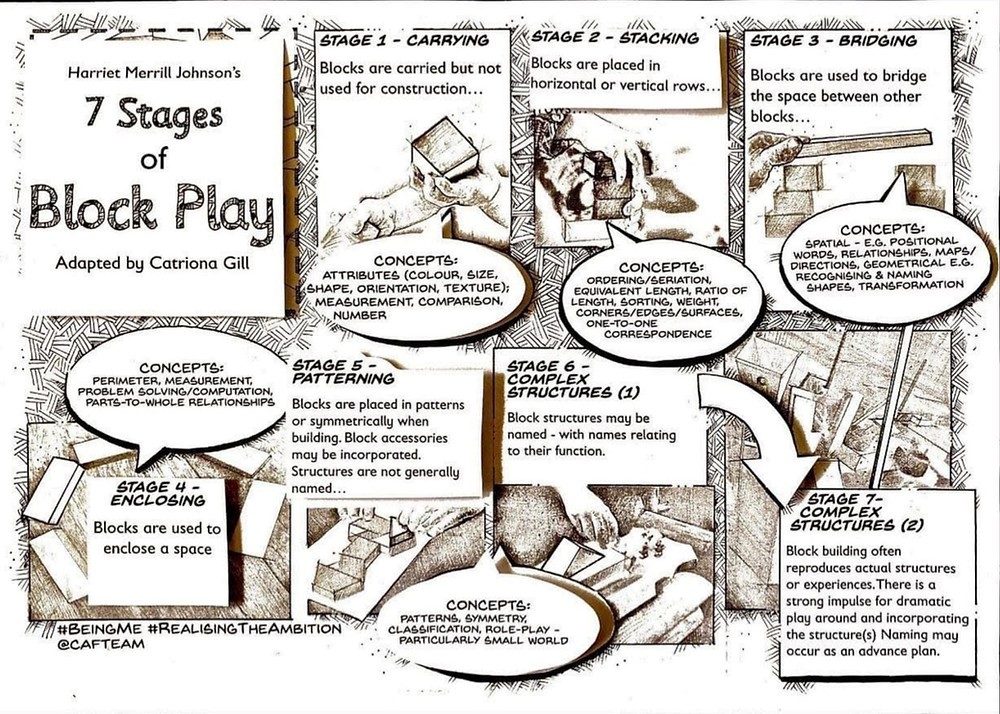Block Play – the 7 stages
As children’s brains and bodies develop and mature throughout the early years of their lives, and as their skills and confidence grow, they will approach block play in different and progressively more complex ways. Although the materials they use might essentially remain the same, how they use and combine them will show how the child’s thought processes and understanding of the world around them are constantly developing.

To help us plan for children’s next steps in learning through block play, it can be helpful to broadly categorise children’s use of building blocks into seven main stages:
- Exploring and Carrying: Even before children are mature enough to consider the possibility of combining their blocks in different configurations, they will still show their interest in the basic materials by picking them up, carrying them in their hands, and eventually putting them down. They will use all of their senses to explore the materials and become familiar with their shape, weight, and taste. At this stage, many children will also take great delight in knocking brick structures over – often to the dismay of their peers!
- Stacking: This phase mainly occurs at around 2-3 years of age in most cases. The child will begin to explore the idea of stacking blocks either vertically, placing one brick on top of another until a tower is formed, or horizontally, to create a trail of bricks along the play surface. As a rough guide, we might expect a child of 15 months to stack two blocks in their tower; a child of 18 months will likely be able to balance three blocks; from around age 2, this will increase to 6 or 7 blocks; and from 2 and a half years old the child will most likely be extending their tower beyond 7 blocks.
- Bridge-building: This phase usually occurs after the child has achieved a certain confidence level in stacking. At this stage, children will attempt to balance longer bricks across gaps in their structures to create a bridge between them.
- Enclosures: At around four years old, children will begin to lay their blocks end-to-end to create enclosures, building walls that will surround and enclose a chosen area (see schemas). Often they will assign these structures with a specific role – for example, a rectangular arrangement of joined-up bricks might represent a house, a garage, a castle or a zoo.
- Patterns and Symmetry: At this stage, the children’s structures will take on an added element of sophistication as they begin to explore similarities and differences between the assorted properties, shapes and sizes of the bricks they are using. Their arrangements of the bricks will often show that some thought has been put into making sure that both sides of a structure match, for example, demonstrating a blossoming awareness of the concept of symmetry. At this stage, the child may also be interested in combining their blocks with other toys – their creativity will be enhanced by allowing them to add cars, animals, or dinosaurs to their structures. This can often lead the child to formulate their own imaginative narratives using whatever toys they have access to in their play space.
- Structures – Early Representational: During this phase, at around 4-5 years old, children will begin to create structures that more accurately reflect their observations of real-life settings, they will start to think in more detail about how they can use their building materials to represent locations from their own everyday environment.
- Structures – Later Representational: Once children have begun to consider ways in which their structures can replicate real life, this later stage will see them continue to elaborate on that concept, adding increasingly complex levels of detail to more fully recreate what they have observed.
It can be a good idea for practitioners to identify roughly what stage of this continuum their children are currently working on to both support their efforts and to know when it might be suitable to introduce additional materials, adult input or stimuli that will extend each child’s learning and facilitate their continuing progression.
See How to Support Play in the Block Area for further details and examples of different stages for identification practice.
